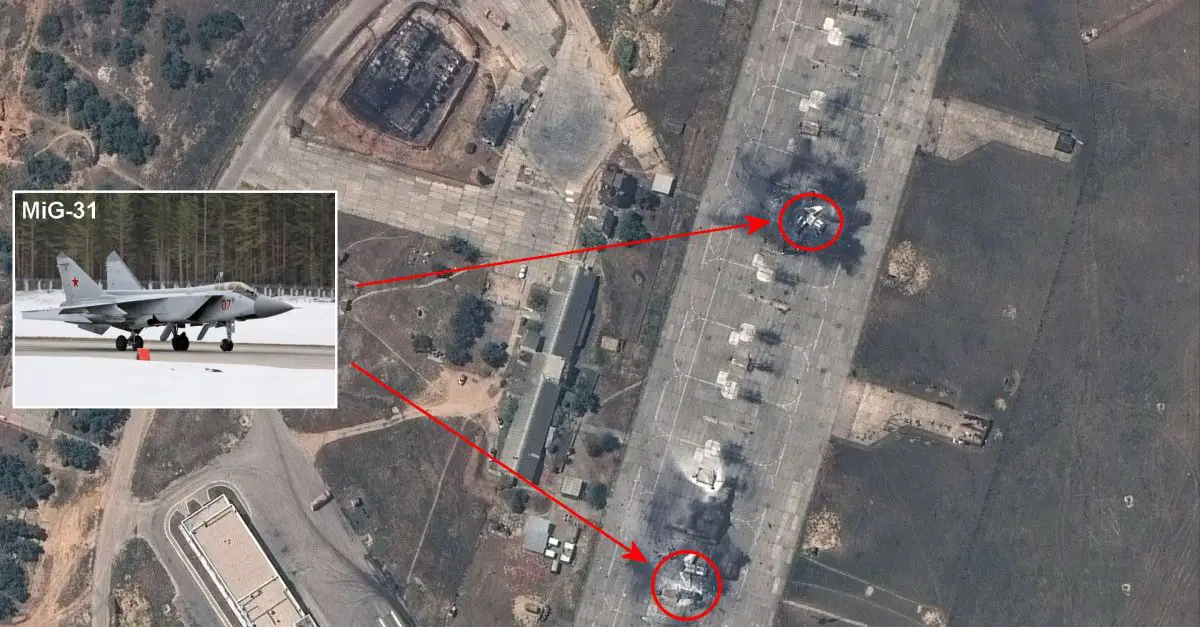Breaking news
British Intel Reports Major Damage to Russian Military Fighter Jets & Air Defense Systems in Crimea from Ukrainian Strikes.
The British Army Intelligence Services reported on May 18, 2024, significant damage to Russian military aircraft and air defense systems in Crimea following a series of targeted attacks by Ukrainian forces on May 14, 2024. The strikes, aimed at Russian military installations on the illegally occupied territory, resulted in the destruction of advanced air defense systems and high-value aircraft. Specifically, elements of an SA-21 Air Defense missile battery, including the sophisticated GRAVE STONE radar and multiple missile launchers, were destroyed at Belbek Airfield. Additionally, at least two MiG-31BM FOXHOUND C aircraft, known for their high-speed interception capabilities, were destroyed on the ground during the operation.
Follow Army Recognition on Google News at this link

Satellite images published on X after the Ukrainian ATACMS strikes reveal the destruction of at least two MiG-31 aircraft, as well as significant damage to infrastructure at the Russian Belbek Air Force Base in Crimea. (Picture source: MAXAR via X Account Christiaan Triebert)
According to public sources, the successful attack was carried out using ATACMS missiles. These precision-guided missiles have a long-range capability, allowing Ukrainian forces to strike high-value targets deep within enemy-held territory. The use of ATACMS in this operation underscores Ukraine's increasing ability to conduct precise, long-range attacks, significantly impacting Russian military operations and infrastructure in Crimea.
In response to the recent Russian offensive against Kharkiv, Ukrainian forces have conducted strategic attacks on Russian military targets in Crimea. This escalation follows increased Russian military activities in the Kharkiv region, which began on May 10, 2024. The Russian offensive aimed to capture key positions in Kharkiv Oblast, but Ukrainian defenses have managed to stabilize the situation despite heavy fighting and significant Russian losses.
These operations are part of Ukraine's broader strategy to degrade Russian military capabilities in occupied Crimea. Ukrainian forces have increasingly utilized long-range drones and missiles to hit strategic targets, significantly impacting Russian air defense and operational readiness in the region (Wikipedia). The ongoing conflict in Kharkiv and subsequent Ukrainian strikes in Crimea illustrate the escalating tensions and the complex military dynamics in the region.
Initial reports indicate that elements of an S-400 NATO-code named SA-21 Triumf Air Defence missile battery at Belbek Airfield were destroyed, including a GRAVE STONE radar and multiple launchers. Additionally, at least two MiG-31BM FOXHOUND C aircraft were destroyed on the ground during the operation.
Satellite imagery taken on May 16, 2024, corroborates these findings, showing the complete destruction of two MiG-31 fighter jets and a Su-27 fighter jet. The imagery also indicates that a MiG-29 fighter aircraft was damaged. Pictures released on May 17, 2024, by Christian Triebert via X, using Maxar imagery, confirmed the destruction at Belbek Airbase, including a destroyed nearby fuel storage facility, with debris still burning in the aftermath.
This strategic attack marks a significant escalation in Ukraine's use of long-range drones and missiles to target critical Russian military infrastructure far behind the front lines, specifically in Crimea, which has been under Russian control since its annexation in 2014.
This incident represents the fourth significant loss for Russian Air Defense in Crimea over the past month. Previous successful actions by Ukrainian forces targeted the Ai-Petri Air Defence Radar site on May 12, 2024, and the Dzhankoy airfield on April 16 and April 29, 2024. These continuous strikes have collectively degraded Russia's capability to defend its airspace around Crimea and highlighted Ukraine's increasing ability to disrupt Russian Air Defense operations.
Military analysts suggest that the cumulative impact of these strikes will likely force Russia to disperse its air assets to mitigate further losses. This redistribution could reduce the presence of A-50U MAINSTAY aircraft, thereby increasing the burden on fighter aircraft patrols to fill the coverage gaps. Such adjustments are expected to elevate maintenance demands on the Russian fleet, potentially compromising their operational readiness.
As the conflict continues, the ability of Ukrainian forces to strike deep into occupied territories poses a significant challenge to Russian military strategy, potentially altering the dynamics of air defense and aerial superiority in the region.


























